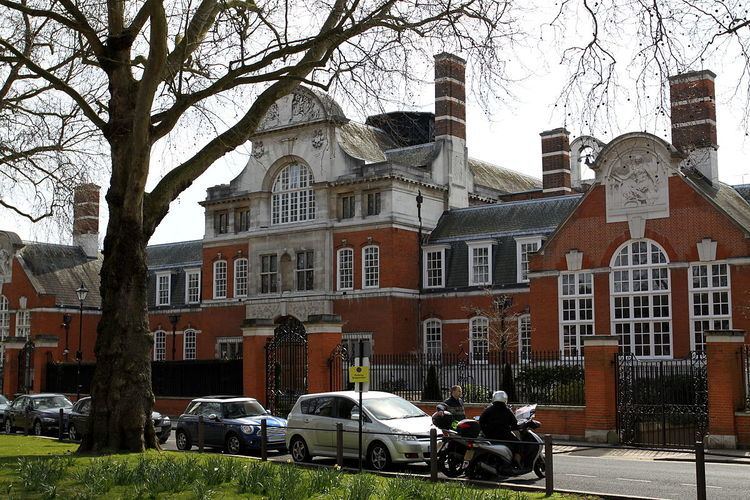Established 1904 High Mistress Clarissa Mary Farr DfE number 205/6011 Founded 1904 | Chairman of Governors The Hon Timothy Palmer Phone +44 20 7603 2288 Number of students 770 | |
 | ||
Location Brook GreenLondonW6 7BSEngland Founder Worshipful Company of Mercers Similar Westmins School, Latymer Upper School, St Paul's School, The Godolphin and Laty, City of London School fo | ||
St Paul's Girls' School is an independent day school for girls, located in Brook Green, Hammersmith, in West London, England.
Contents
History
St Paul’s Girls’ School was founded by the Worshipful Company of Mercers in 1904, using part of the endowment of the foundation set up by John Colet, to create a girls’ school to complement the boys' school he had founded in the sixteenth century. The governors hold proprietorial responsibility, and some are representatives of the Universities of Oxford, Cambridge and London.
The buildings for the school were designed by the architect Gerald Horsley, the son of the painter John Callcott Horsley and one of the founder members of the Art Workers Guild.
The school has had several distinguished directors of music, most notably Gustav Holst (1905–34) and Herbert Howells (1936–62). Holst composed his St Paul's and Brook Green suites for the pupils at the school. Holst also composed what is arguably his most well known work, "The Planets", while teaching at St Paul's.
Exam results
St Paul's girls have regularly performed extremely well in the GCSEs and A Levels. Over half of girls at the school get all A*s in their GCSEs and many take extra languages or maths GCSEs. In 2014, 99.3% of GCSEs were graded at A*s or As with 93.6% graded at A* alone. This was the highest ever A* percentage achieved by the school and in the country. In 2016, the school achieved the highest A Level results in its history with 60.0% of entries achieving an A* grade and 93.8% of entries achieving A* or A grades.
GCSE summary: last five years
A level summary: last five years
Music
Gustav Holst was Director of Music at the school during the period he composed his orchestral suites, including St Paul's Suite and The Planets; he was succeeded by Herbert Howells before John Gardner followed in the 1960s. Gardner wrote many memorable pieces for the school, including his popular Christmas carols Tomorrow Shall be My Dancing Day and The Holly and the Ivy.
Drama
The school's main theatre, where most school productions are staged, is named after alumna Celia Johnson. Other productions are staged in the drama studio is a smaller space.
Bursaries
The school awards up to twenty means-tested bursaries to students who join in Y7 (two of which are funded by HSBC), and up to five more bursaries for students arriving in Y12. For candidates who join in Y12, there is also the Ogden Trust science award for a UK citizen currently at a non-independent school who wants to study both physics and maths at A level. Bursaries fund up to 100% of tuition fees on a sliding scale depending on family income and assets, plus exam entry fees and a grant towards textbooks. Holders of 100% bursaries entering in Y12 also receive an extra package to cover additional expenses, such as the cost of sports equipment and music tuition.
Scholarships
Year 7: The school awards up to four academic scholarships and two music scholarships to 11+ entrants (worth £100 a year; the music scholarship also includes free tuition in one instrument).
Year 12: The school may also award two music scholarships to current students and two more to new joiners (worth £250 a year plus free tuition in two instruments), and two art scholarships (worth £250 a year) to internal and external candidates. The Nora Day music scholarship (worth up to 50% of school fees plus free tuition in two instruments) is awarded every other year to a new joiner who shows exceptional musical potential. The school also awards scholarships worth £250 a year for academic distinction in the "Senior Scholarship", a dissertation written by students in Y12 during the Summer holiday following their AS exams.
Logo
The school logo is a Grecian laurel wreath, representing the school’s competitive spirit. In 2007, this logo was replaced by High Mistress Clarissa Farr with a blossoming rose, chosen to suggest potential. The change provoked much opposition from students within the school, and an article in the Daily Mail. The traditional wreath was retained as the symbol of the Old Paulina Alumnae Association. In 2013 it was announced that the old logo would be reinstated.
High Mistresses
The headmistress of St Paul's Girls School is known as the High Mistress.
Notable Old Paulinas
Alumnae of the school, known as "Old Paulinas", include:
Culinary arts
Education
Humanitarianism
Law
Politics
Science
Sport
Notable former staff
Feeder prep school
St Paul's does not have a formal preparatory school, but many girls from Bute House Preparatory School for Girls join St Paul's owing to the two schools' proximity.
